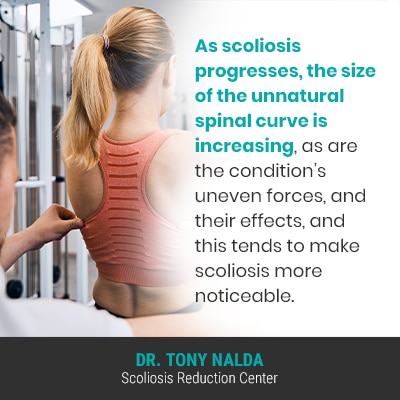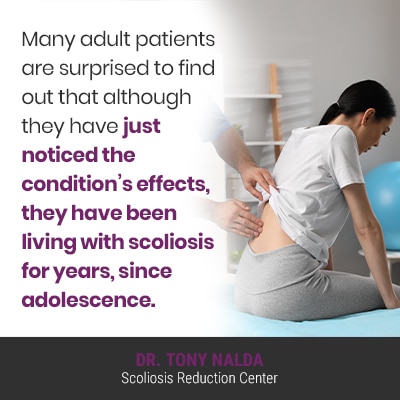Scoliosis can affect all ages, but is most commonly diagnosed in adolescents as adolescent idiopathic scoliosis (AIS). In children, the condition’s early signs can be subtle, and scoliosis isn’t commonly painful, so early detection can be that much more difficult to achieve; in adults, once the condition becomes compressive, pain makes the condition easier to recognize and diagnose.
Scoliosis involves the development of an unhealthy sideways-bending spinal curve that also twistsing unnaturally. As a condition that ranges so widely in severity, every case is unique, and particularly when mild, patients can be living with scoliosis for years unaware.
To address the topic of scoliosis awareness, let’s start with how scoliosis is diagnosed and the condition’s progressive nature.
Diagnosing Scoliosis
There are a number of spinal conditions that cause a loss of its healthy curves, but scoliosis is a particularly complex condition with some unique characteristics.
As mentioned, scoliosis doesn’t just cause the spine to bend unnaturally to the side, but also twist, making it a complex 3-dimensional condition.
Scoliosis is also a progressive condition, meaning it has it in its very nature to get worse over time, and this is an important factor to understand because scoliosis isn’t a static, so where it is at the time of diagnosis, in terms of severity, doesn’t mean that’s where it will stay.
In general, the more severe a condition is, the more noticeable its effects are going to be, and the more severe a condition, the more complex it is to treat.
To reach a diagnosis of scoliosis, the size of the unnatural spinal curve has to fulfill a size requirement: a minimum Cobb angle measurement of at least 10 degrees.
A patient’s Cobb angle is a key piece of information that potentially-effective treatment plans are shaped around.
Cobb angle is determined during X-ray by drawing lines from the tops and bottoms of the curve’s most-tilted vertebrae (bones), and the resulting angle is expressed in degrees:
- Mild scoliosis: Cobb angle measurement of between 10 and 25 degrees
- Moderate scoliosis: Cobb angle measurement of between 25 and 40 degrees
- Severe scoliosis: Cobb angle measurement of 40+ degrees
- Very-severe scoliosis: Cobb angle measurement of 80+ degrees
A condition diagnosed as mild can easily progress to become more severe and noticeable; only proactive treatment can work towards counteracting the condition’s progressive nature.
Proactive conservative treatment starts as close to the time of diagnosis as possible as this is when conditions are at their mildest, the curves are the smallest they’re going to be, the body hasn’t yet had ample time to adjust to the condition’s presence, and the spine is at its most responsive.
As a scoliotic curve gets larger, it becomes more rigid and less responsive to treatment; it’s far more effective to proactively work towards preventing progression and increasing condition effects, than it is to attempt to work towards reversing those effects once they’re established.
So as our current topic is whether or not people can live with scoliosis without knowing, the answer is a resounding yes; in fact, it’s a surprisingly common scenario that adults recently diagnosed with scoliosis find out they’ve had it since adolescence.
Let’s now talk specifically about the condition’s effects, and how they differ in children versus adults, and what that means in terms of recognizing the condition’s symptoms and presence.
How Scoliosis Affects Children

Scoliosis can be diagnosed at any age, and as mentioned, the most-prevalent type is adolescent idiopathic scoliosis, diagnosed between the ages of 10 and 18, so we’ll focus on this type for our current purposes.
Now, when scoliosis develops in an adolescent, this age group is at risk for rapid-phase progression because scoliosis progression is triggered by growth, and what does puberty consist of: rapid and unpredictable growth spurts.
As scoliosis progresses, the size of the unnatural spinal curve is increasing, as are the condition’s uneven forces, and their effects, and this tends to make scoliosis more noticeable.
In fact, here at the Scoliosis Reduction Center®, the majority of my adolescent patients are diagnosed in the moderate stage of progression because the signs of mild scoliosis are subtle, and it’s not until progression occurs that the condition’s telltale signs become noticeable enough to bring patients in for a diagnosis.
The main effect of scoliosis in children is postural deviation, and this is due to the condition disrupting the body’s overall symmetry:
- Uneven shoulders
- Uneven shoulder blades
- The development of a rib cage arch
- An uneven waistline
- Uneven hips
- Arms and legs that appear to hang at different lengths
Additional changes to watch for can include changes to balance, coordination, and gait.
As scoliosis doesn’t become a compressive condition until skeletal maturity has been reached, it’s not commonly described as painful for adolescents, and this is another reason behind why a young person could be living with scoliosis unaware.
In children who are still growing, their spines are experiencing a constant lengthening motion that counteracts the compressive force of the unnatural spinal curve, and it’s compression of the spine and its surrounding muscles and nerves that causes the majority of condition-related pain.
So now let’s look at scoliosis in adults and why the condition’s effects tend to be more noticeable.
Scoliosis in Adults
Once scoliosis becomes compressive, it causes back pain and pain that radiates into the extremities due to nerve compression, and pain is the number-one symptom that brings adult patients in to see me for a diagnosis and treatment.
Many adult patients are surprised to find out that although they have just noticed the condition’s effects, they have been living with scoliosis for years, since adolescence.

The main type of scoliosis to affect adults is idiopathic scoliosis, and these are cases of adolescent idiopathic scoliosis that were left undiagnosed and untreated during adolescence, so the conditions progressed with time and maturity into adulthood, when conditions become painful, noticeable, and are commonly diagnosed years later than they should be.
The unfortunate reality is that had these patients received a diagnosis and treatment during adolescence, their spines would be in far better shape than they are by the time they receive their diagnosis; however, it is never too late to start treatment, and condition improvements can almost always be worked towards.
In adults, as the progressive trigger of growth is removed, progressive rates tend to slow down, and the focus of treatment is on stabilizing the spine, pain management, and reducing the size of the scoliotic curve back to where it was prior to becoming painful.
The second most common type of scoliosis to affect adults is known as de novo scoliosis and/or degenerative scoliosis; this develops fresh in adulthood with no prior history with the condition, unlike idiopathic scoliosis in adults.
Degenerative scoliosis is caused by age-related spinal degeneration and the cumulative effect of negative lifestyle choices.
When it comes to diagnosing scoliosis, when mild, this can be difficult to achieve as the condition’s early signs are often too subtle for anyone, other than experts trained in the subtle telltale signs of scoliosis, to recognize.
While there are never guarantees, the sooner treatment is started, the better; scoliosis is virtually guaranteed to get worse over time, and as progression occurs, the condition only gets more complex to treat.
Conclusion
While it can be difficult to imagine a person living with an unnaturally-curved spine without knowing, this is a common scenario.
The Scoliosis Research Society has current estimates at close to seven million people living with scoliosis in the United States alone, and this is only an estimate including known diagnosed cases; if the number of people living with the condition unaware could somehow be quantified, that number would likely increase exponentially.
The challenge of early detection is being able to recognize the condition’s subtle signs when mild, and this is why most patients are diagnosed after they’ve progressed into the moderate stage of progression as this is when related postural changes tend to become more overt.
The more severe a condition gets, the more uneven forces are introduced to the body, and the more noticeable its effects are likely to be; in children, the most noticeable effect is postural deviation, and in adults, it’s pain.
Knowing the condition’s early signs can help lead to early detection, and while there are never treatment guarantees, early detection and intervention is associated with treatment success.
Even adults who have been progressing unaware since adolescence and have experienced significant progression by the time they receive their diagnosis, condition improvement can be worked towards, and regardless of age or severity, the best time to start scoliosis treatment is always now.




